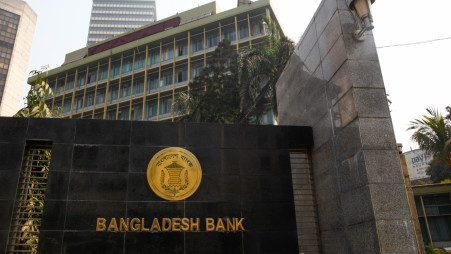Bangladesh Bank cuts reverse repo rate by 50 basis points
Cenbank move expected to boost credit availability in the economy

As inflationary pressure continues to ease, the Bangladesh Bank today (15 July) reduced the Standing Deposit Facility (SDF) rate, also known as the reverse repo rate, by 50 basis points to 8%, effective from tomorrow.
With this move, the central bank aims to encourage banks to lend more to businesses and consumers rather than park surplus funds with the central bank.
Bankers and economists say the decision is expected to boost credit availability in the economy and may lead to lower market interest rates.
However, the overnight repo rate, the central bank's main policy rate, remains unchanged at 10%. The upper limit of this corridor, the Standing Lending Facility (SLF), will also remain unchanged at 11.5%.
In a circular issued today, the central bank stated that the move is aimed at enhancing liquidity management and stimulating activity in the interbank call money market, under the framework of the monetary policy's interest rate corridor.
Professor Mustafizur Rahman, a distinguished fellow at the Centre for Policy Dialogue (CPD), told TBS, "The central bank might decide to cut the SDF rate for two reasons: to activate the call money market and to encourage banks to increase lending to the private sector. However, this rate reduction could also have other impacts on the banking sector."
A senior central bank official explained that banks have recently shown a growing tendency to deposit funds with the central bank under the SDF, even at a lower interest rate, rather than lending to other banks in the call money market. "The reduction in the SDF rate is designed to incentivise banks to become more active in the interbank market."
However, a policymaking official from a private bank shed light on a key reason for this trend. "While many banks, particularly weaker ones, are keen to borrow in the call money market, there is uncertainty about timely repayment. Past experiences of delayed returns on loans to these banks have made commercial banks more inclined to deposit their funds with the central bank at a lower interest rate, prioritising security over higher returns."
Syed Mahbubur Rahman, managing director and CEO of Mutual Trust Bank, said, "Despite interest rates in the call money market exceeding 10%, many banks are being cautious when lending, preferring to only lend in the call money market to banks from which they are confident of recovering their funds. The remaining liquidity is being placed in the SDF."
The banker noted that the reduced demand for private sector loans is also limiting investment opportunities for banks.
The country's GDP growth slipped to 3.97% in FY25, the lowest since the Covid-19 pandemic in FY20.
Credit to the private sector – the primary engine of the country's economic activity and job creation – grew by only 7% in the first quarter of 2025, marking a decade-low.
Inflation rate, however, dropped below 9% for the first time in 27 months in June, reaching 8.48%. The rate had remained above the 9% mark since March 2023. During the period, the highest recorded inflation was 11.66% in July 2024.



 Keep updated, follow The Business Standard's Google news channel
Keep updated, follow The Business Standard's Google news channel















